A call to raise awareness and mobilize action for a just and inclusive transition to clean energy for the benefit of people and the planet.
Don't wanna be here? Send us removal request.
Text
Tracking SD7.

The Energy Progress Report aims to provide the international community with a global dashboard to register progress on energy access, energy efficiency, renewable energy and international cooperation to advance SDG 7. It assesses the progress made by each country on these four pillars and provides a snapshot of how far we are from achieving the 2030 Sustainable Development Goals (SDG) targets...

#renewable energy sources#sustainable energy#Energy progress report#global dashboard#sdg7#clean energy#international day of clean energy#Energy Progress Report#solar energy#onshore wind power#wind energy#energy sources#clean energy sources
0 notes
Text
So, what are we looking forward to in 2025?

Global energy investment is projected to surpass USD 3 trillion in 2024, with USD 2 trillion allocated to clean energy technologies. We see 2025 being the year when renewable energy investments continue to far outpace new fossil fuel investments. At the same time, we foresee key players directing more investments into emerging and developing economies, suggesting a potential new trend.
Energy is at the heart of the climate challenge – and key to the solution. We saw in 2024, global temperatures hitting record highs and extreme weather events affecting people in all corners of the world. Considering this existential threat to our planet, 2025 must be the moment for the global community to double down on the efforts to reduce emissions and limit temperature rise.
The Nationally Determined Contributions (NDCs), which are national climate action plans, will take centre stage. The current NDCs limit the global temperature increase to between 2.4 to 2.6°C equating to a reduction of 5.3% of greenhouse gas (GHG) emissions by 2030. However, according to the IPCC, a decrease of 43% is needed to limit temperature rise.
Therefore, the NDC 3.0 process that will culminate in February 2025 – the deadline for countries to submit their updated NDCs – will be another major moment and we hope that there will be strong commitments and proactive responses to the 2023 global stocktake decision.
COP29 saw the reversal of hard-won gains as there was no agreement on phasing out of fossil fuels, and the new climate finance goal of USD 300 billion annually by 2035, is viewed as largely inadequate. COP30, hosted by Brazil, will be a major moment to recalibrate our collective fight against climate change. We are thrilled that the SEforALL Global Forum is one of the key milestone moments on the road to COP30, where global leaders and changemakers will look to secure even greater commitments for a just and equitable energy transition, combining learnings from the Bridgetown Initiative, with the people-centered approach driven by the Brazilian Presidency to further enable the advancement of clean energy solutions in underserved sectors and markets.
Finally, there has been a growing trend of developing countries showing their leadership on the global stage, when it comes to issues on climate, development and energy. We do see this trend continuing in 2025 with these countries working towards improving access to energy for their people, while contributing to the global fight against climate change.
There is a win-win potential that can be gained from collective action. The global community must continue to work with developing countries and provide the needed finance and technical assistance that can go well beyond supporting their economic development. With a growing number of youth, abundant renewable energy resources and increasing improvements in policies, these countries could provide a pathway for a more inclusive, green and prosperous world. That is our driving force and resolution for 2025!
#Global energy investment#clean energy technologies#energy access challenge#solar energy#energy compacts#sustainable energy#climate driven electricity demand#sdg13#renewable energy sources#investing in renewables#international day of clean energy#renewable power#clean energy solutions#sdg7#clean energy
0 notes
Text
2025 – Time to get global energy goals back on track.

Where did the year go? That’s what many practitioners we meet are saying.
This indicates how busy we’ve all been, working towards ensuring everyone, everywhere, can live a dignified life on a healthy planet, powered by sustainable energy.
2024 saw the revelation that we are backsliding when it comes to energy access targets, the SDG7 Tracking Report showed that for the first time in over a decade, electricity access was unable to keep up with population growth. The SEforALL analysis also showed that apart from progress in a handful of countries, we are also backsliding in the provision of clean cooking technologies and fuels. If we are to achieve SDG7 by 2030, we must provide electricity access to 157,000,000 people per year; and increase clean cooking access by 334,000,000 people each year!
It is a herculean task, but not an insurmountable one.
This is why Mission 300, the ambitious initiative unveiled in April 2024 by the World Bank and the African Development Bank, working with SEforALL, the Global Alliance for People and Planet (GEAPP), and The Rockefeller Foundation is so significant. It would halve the number of people living without electricity in Sub-Saharan Africa and meet the needs of 43% of those living without electricity globally. In addition, no progress happens in isolation, Mission 300 would help catalyse clean energy markets in countries with widespread energy poverty, offering price discovery gains, business models and delivery mechanisms at scale that can help accelerate progress far beyond the 300 million people that will be the direct beneficiaries of this effort.
Another notable mechanism working towards solving the energy access challenge is the Energy Compacts, hosted by UN-Energy and championed by SEforALL, which have increased ambition towards SDG7. The total finance committed through the Energy Compacts has grown from USD 400 billion in 2021 to USD 1.4 trillion in 2024.
By generating further leadership and investment, these Energy Compacts are set to drive substantial actions, including phasing out coal-fired power, decarbonizing energy systems, and promoting economic growth and job creation, thus contributing robustly to the global agenda of achieving the SDGs by 2030.
#energy goals#Global Alliance for People and Planet#african development bank#Energy Compacts#UN-Energy#leadership and investment#energy access challenge#electrificaton#decarbonizing energy systems#sdg13#sdg8#sustainable development goal 7#sdg7
0 notes
Text
EOSG Member States Briefing on SG's Panel on Critical Minerals.
As minerals extraction accelerates to match the needs of the energy transition, it is crucial to ensure that the countries and local communities endowed with these resources are the ones to benefit the most.
The Secretary-General's Panel on Critical Energy Transition Minerals seeks to build trust between governments, local communities and industry, by addressing issues relating to equity, transparency, investment, sustainability and human rights. It builds on existing standards and initiatives, particularly the Working Group on Transforming the Extractive Industries for Sustainable Development and its flagship initiative, 'Harnessing Critical Energy Transition Minerals for Sustainable Development,' to strengthen and consolidate existing efforts.
Related Documents
The UN Secretary-General's Panel on Critical Energy Transition Minerals website
Watch EOSG Member States Briefing on SG's Panel on Critical Minerals!

#critical minerals#raw materials#energy transition#ecosoc#panel discussion#mineral extraction#extractive industry#unhq#sdg7#mineral resource#flagship initiative#sustainability#sustainable development#build trust#local communities#mining#state governments#Working Group on Transforming the Extractive Industries for Sustainable Development
0 notes
Text
Global Energy Interconnectivity and Transition for SDGs (HLPF 2024 Side Event).
This side event aims to summarize the substantial progress and practical cases of the global energy transition. Exchanging experiences from around the world has never been more important.
Accelerating the global energy transition and promoting clean, low-carbon electricity development are critical measures in urgently addressing climate change. The top priority is to hasten the worldwide adoption of clean energy and to advance the green, low-carbon development of the electricity sector. Around the world, nations are pursuing sustainable development in the electric sector through various approaches and focuses, leading to different levels of progress.
Organized by the Global Energy Interconnection Development and Cooperation Organization (GEIDCO)
Co-organizers: Permanent Mission of the People's Republic of China to the UN, UNESCAP, UNECE, UNESCWA, UNSDSN, and OLADE.
Related Sites and Documents
Concept note Website (English) Website (Chinese)
Watch the Global Energy Interconnectivity and Transition for SDGs (HLPF 2024 Side Event)

#Permanent Mission of the People's Republic of China to the UN#UNESCAP#UNECE#UNESCWA#UNSDSN#olade#side-events#HLPF2024#energy#sustainable energy#Energy connectivity#energy transition#electricity sector#sdg7#climate action#sdg13
0 notes
Text
Help us secure a cleaner, healthier, and prosperous future for all.

But we need to keep pushing further—and the fossil fuel industry and its friends in power are fighting hard to undermine our progress.
Contribute to cut emissions 42 percent by 2030.
Giving Our Planet a Fighting Chance (PDF).

#emissions reduction#clean energy sources#renewableenergy#renewable power#renewablefuture#renewable energy sources#sustainable energy#sdg7#fossil fuel industry#nrdc
0 notes
Text
Solar energy will triple by 2030 in the United States.

A worker inspects newly made solar panels at the SunSpark Technology manufacturing facility in Riverside, California.
Keefe tracks the innovation and investment that’s creating good-paying jobs, transforming the American economy into a,dynamo, and strengthening the supply chain for the building blocks of a modern society. He has a gift for summing up the sweep of this epic shift. “If projections are right,” Keefe writes, “wind energy in America will double by 2030. Solar energy will triple. Battery storage will increase by a factor of nine. And the number of EVs (electric vehicles) on the road will increase twenty-six-fold.".
New Book Puts Human Face on Epic Clean Energy Boom.
#supply chain#pv#solar photovoltaic (pv)#building blocks#Battery storage#international day of clean energy#manufacturing renaissance#NRDC
0 notes
Text
Power generation from renewable energy resources plays an essential role in Europe’s transition to a decarbonized energy system.
The European State of the Climate (ESOTC) report reveals that a record 43% of actual electricity generation in Europe came from renewable sources, up from 36% in 2022. For the second consecutive year, energy generation from renewables overtook the generation from polluting fossil fuels. The largest source is biomass, which is not covered in this report. Until 2018, hydro-power was the second largest renewable energy source, but that position has now been taken by wind power. The total installed capacity of wind and solar power has been steadily increasing over the past two decades.
Renewable energy resources and electricity demand are highly sensitive to climatic conditions, which are subject to long-term trends and fluctuations on timescales ranging from days to decades. With Europe’s increasing move to renewable resources for its electricity supply, monitoring and understanding their temporal and spatial variability, and how they may be changing in a warming climate, is becoming more vital. It is important to assess how these variations affect both the demand for electricity and the potential for renewable energy generation.
This section provides an overview of actual electricity generation in Europe in 2023. It then explores the implications of climate conditions for potential power production for onshore wind power, solar photovoltaic (PV) and run-of-river hydropower, and on electricity demand. Only climate-dependent variations are taken into account; all other factors, such as variations due to improvements in the efficiency of the technology, are taken as constant. Other assumptions, such as the homogenous distribution of production units for wind and solar power across Europe, are also made. Potential power generation is represented as capacity factor (CF) – the ratio between the average power potentially delivered and the theoretical maximum power. CF ranges in value between 0, when no power is delivered, and 1, when the delivered power is equal to the theoretical maximum power of the system.
Measured electricity generation and demand in 2023
Figure 1a. Percentage of the total actual annual electricity generation from 2016 to 2023 for Europe, from solar (yellow), wind (purple) and hydro (blue) power, and other sources, including other renewables and fossil fuels (grey). Total generation in TWh is shown in Figure S1[5]. Data source: ENTSO-E and Elexon.
In 2023, electricity demand across Europe was the lowest in eight years, at around 2.6 PWh. The year saw a record share of electricity generation from renewables, at around 43%, with 17% from hydropower, 18% from wind power and 7% from solar power. Solar and wind energy tend to follow a complementary seasonal cycle: solar power generation is naturally highest during spring and summer, while wind power produces more electricity in autumn and winter.
Climate-driven electricity demand and potential for generation in 2023
Figure 2. Anomalies (%) in potential electricity generation from three renewable sources in 2023: onshore wind capacity factor (top left), solar photovoltaic capacity factor (top right), run-of-river hydropower capacity factor (bottom left); and in climate-driven electricity demand (bottom right). All anomalies are relative to the average for the 1991–2020 reference period and expressed as a percentage of this average. Countries shaded in grey are those for which no data are available, except for solar PV for which these countries are not shown. Data source: C3S Climate and Energy Indicators for Europe.

The climate-driven electricity demand in countries in central and eastern Europe was close-to or below average for the year as a whole. This is consistent with warmer-than-average temperatures experienced across much of Europe, notably during the winter and autumn, and a corresponding reduced demand for heating. Conversely, climate-driven electricity demand was above average in parts of southern Europe, particularly Spain and Italy, and in Norway and Sweden. In southern Europe, this was largely due to high summer temperatures, leading to increased demand for cooling; in Scandinavia, it was linked to the well-below-average temperatures experienced during several months that increased the demand for heating. More on temperature conditions can be found in the ‘Temperature’ and ‘Contrasting summer’ sections.

Potential electricity generation from wind was above average in central and southeastern parts of Europe, and below average in Spain, the UK, Iceland, Fennoscandia, and parts of northeastern Europe.

Potential electricity generation from solar was below average in northwestern and central parts of Europe, and above average in southwestern and southern Europe, and Fennoscandia. Solar CF is closely related to surface solar radiation, but other technological factors also play a role. For example, while solar radiation was well above average across much of northern Europe in May and June, the potential for solar generation was not as high, as not all solar radiation is converted into power, particularly at high temperatures. Therefore, averaging across the year results in lower potential power generation from solar PV, compared to the anomalies in solar radiation.
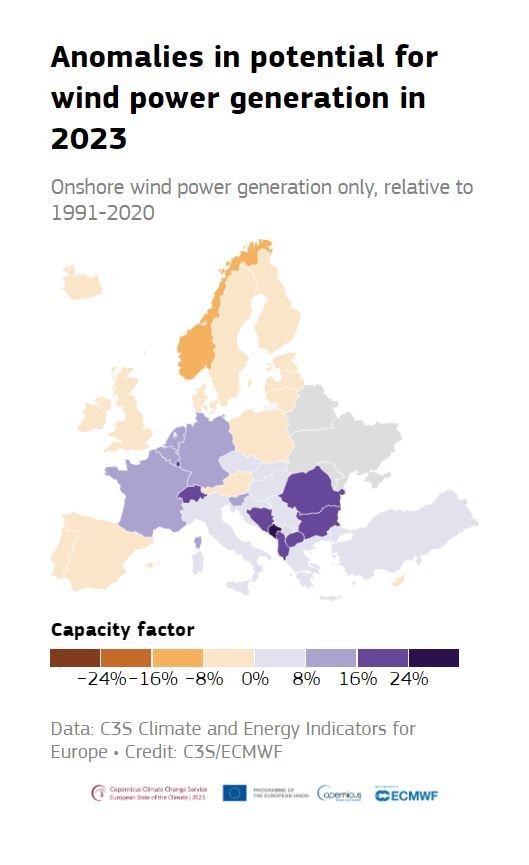
For run-of-river hydropower, potential electricity generation was above average across much of Europe, except for Spain, Norway and Romania. This largely reflects regional anomalies in precipitation. Similarly, the month-to-month variability in hydropower CF, discussed below, reflects anomalies in monthly average river flow across the European river network.
Variability throughout the year
Potential power generation from renewable sources and climate-driven electricity demand both change throughout the year, due to variability in weather and climate. Below, June and November are discussed, to demonstrate this variability between warmer and cooler times of year.
Onshore wind power
Figure 3. Average onshore wind power capacity factor anomaly (%) for June 2023 (left) and November 2023 (right), relative to the respective monthly average for the 1991–2020 reference period and expressed as a percentage of this average. Countries shaded in grey are those for which no data are available. Data source: C3S Climate and Energy Indicators for Europe.
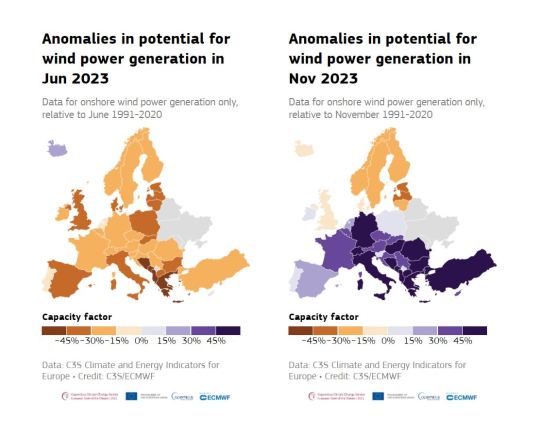
In June, wind power CF was below average across Europe, except for Iceland, with the largest anomalies observed in Serbia, Bosnia and Herzegovina, and Albania, at up to 64% below average. This reflects below-average wind speeds across all but northeastern Europe and Iceland. In contrast, November saw well-above-average wind power CF anomalies across central and southern parts of Europe, and below-average anomalies in Fennoscandia, the United Kingdom and Iceland. This is consistent with above-average wind speeds observed across most of Europe in the last three months of 2023, associated with storm activity.
Solar photovoltaic
Figure 4. Average solar photovoltaic capacity factor anomaly (%) for June 2023 (left) and November 2023 (right), relative to the respective monthly average for the 1991–2020 reference period and expressed as a percentage of this average. Countries with no data available are not shown. Data source: C3S Climate and Energy Indicators for Europe.
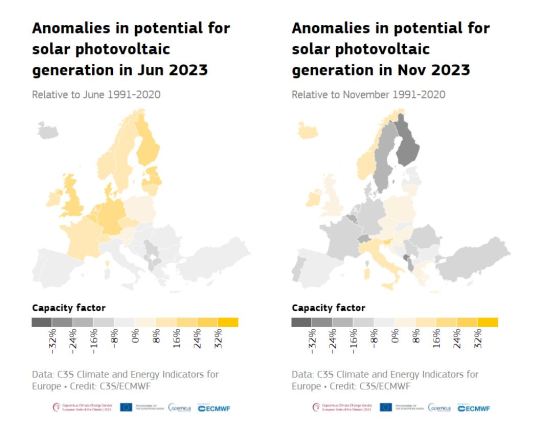
For solar PV power, June saw above-average CF across most of central and northern Europe, and below-average CF across southern Europe and Iceland. This reflects a contrast in surface solar radiation seen across Europe in June. During this month, positive surface solar radiation anomalies, of up to 70 W/m2, were seen in parts of central Europe and Scandinavia, and negative anomalies, as low as -40W/m2, in southern Europe. In November, the solar CF anomalies also corresponded to anomalies in surface solar radiation. Below-average solar radiation and solar PV CF were seen across central Europe, and particularly the Alps, and parts of southeastern Europe and eastern Scandinavia.
Run-of-river hydropower
Figure 5. Average run-of-river hydropower capacity factor anomaly (%) for June 2023 (left) and November 2023 (right), relative to the respective monthly average for the 1991-2020 reference period and expressed as a percentage of this average. Countries shaded in grey are those for which no data are available. Data source: C3S Climate and Energy Indicators for Europe.

In June, below-average run-of-river hydropower CF was seen across much of Europe, while Italy saw well-above-average run-of-river hydropower CF. This reflects positive precipitation anomalies and above-average river flows in Italy in May and June. In November, run-of-river hydropower CF was above average across most of Europe. For most areas, it was 10–20% above average, but it was as much as 57% above average in Portugal and 39% in Switzerland, associated with well-above-average precipitation anomalies and high river flow. The exceptions were Norway and Romania, where slightly-below-average run-of-river hydropower CF was observed, linked to slightly-below-average river flow. More on hydrological conditions in Europe can be found in the ‘Precipitation’ and ‘River flow’ sections.
Climate-driven electricity demand
Figure 6. Average climate-driven electricity demand anomaly (%) for June 2023 (left) and November 2023 (right), relative to the respective monthly average for the 1991–2020 reference period and expressed as a percentage of this average. Countries shaded in grey are those for which no data are available. Data source: C3S Climate and Energy Indicators for Europe.

Climate-driven electricity demand can be linked to factors such as a reduced need for heating when temperatures are warmer than average during winter, and increased need for air conditioning when temperatures are warmer than average during summer.
While the climate-driven electricity demand for the year as a whole was generally below average, it was slightly above average in June across much of western and central part of Europe. These areas correspond to those that saw above-average temperatures during June. However, warmer-than-average temperatures over Scandinavia in the same month corresponded to slightly below-average demand. Later in the year, demand over northern Europe was generally above average. From October to December, temperatures in Scandinavia were much colder than average, reflected in well-above-average demand. In November, however, southern Europe saw below-average demand associated with above-average temperatures for the time of year.
Changes in energy statistics through 2023
While climate conditions can drive demand for additional energy, to some extent they can also compensate through increased potential to generate power. For example, in summer, demand can be higher, but this can be balanced out by additional solar power generation.
Comparison of energy statistics aggregated over a region can highlight links and compensation between climate-driven electricity demand and renewable power resources at a larger geographical scale than that of individual countries[8]. Here, statistics are reported for a region of central Europe, defined here as France, Belgium, Luxembourg, the Netherlands, Germany and Switzerland. These countries are chosen because of their relatively similar climatic conditions in 2023.
Figure 7. Changes in energy statistics for run-of-river hydro-power capacity factor (CF), solar photovoltaic CF, onshore wind CF and anomalies in climate-driven electricity demand for each day in 2023. The daily average CF for the 1991–2020 reference period is indicated by the dashed grey line. Climate-driven electricity demand is expressed as a percentage of the 1991–2020 reference period. Values are averaged across a region of central Europe (here defined as France, Belgium, Luxembourg, the Netherlands, Germany and Switzerland). Data source: C3S Climate and Energy Indicators for Europe.
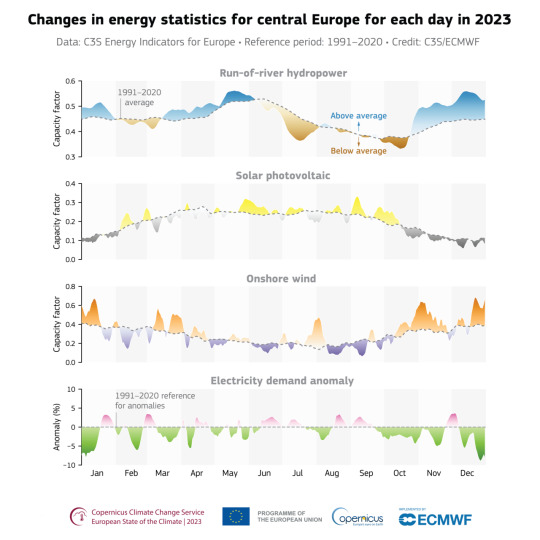
Averaged across six central European countries, the climate-driven electricity demand was below average for most of the year. January, February, October and December saw the largest negative anomalies, with daily values reaching around 7–9% below average in January and December. The lower demand reflected the higher-than-average temperatures during these months and the associated reduced demand for heating. Apart from two weeks in late November and early December, demand was persistently below average from late September until the end of the year.
Climate-driven electricity demand was most above average at the end of January, and in early March, late August, and early December; up to around 3.5% above average during all these periods. The two longest periods of above-average demand were early June to mid-July and mid-August to mid-September. These periods coincided with above-average summer temperatures and the associated demand for air conditioning.
Solar PV CF was above average during several periods in February, May, September and October. September saw the largest positive monthly anomaly, of 18% above average, with daily CF values reaching around 0.3. The increased solar PV CF in September partially compensated for the higher electricity demand.
Onshore wind CF was variable during 2023, but generally above average. There was a long period of above-average CF throughout October and November, which saw daily CF values peaking at around 0.65. November also saw the largest monthly onshore wind CF anomalies, at around 45% above average for the month as a whole. This increase in onshore wind CF was associated with storm activity across much of Europe. February, June and a period from mid-August to the beginning of October saw below-average onshore wind CF, except for a short period of slightly above average anomalies in mid-September. November’s storms continued into December; the associated above-average precipitation and river flow led to above average run-of-river hydropower CF during these two months. At its peak, it reached almost 20% above average, after being close to average for much of the year. July was the only month that saw below-average hydropower CF; as much as 12% below average for the month as a whole.

Monitoring wind, solar , and hydropower is crucial for optimizing the potential for renewable energy generation. Accurate climate monitoring supports strategies to accelerate the transition to sustainable energy sources, fostering both environmental protection and economic growth.
#climate-driven electricity demand#clean energy#capacity factor (CF)#potential power production#onshore wind power#solar photovoltaic (PV)#run-of-river hydropower#and on electricity demand.#energy transition#renewable energy sources#energy sources
0 notes
Text
(Part 2) Global stocktaking marking the completion of the UN Decade of Sustainable Energy for All to further accelerate the implementation of SDG 7 of the 2030 Agenda for Sustainable Development - General Assembly, Sustainability Week, 78th session.
Thematic Debate 2: Addressing energy's interlinkages and strengthening means of implementation and partnerships
Closing segment
Energy is an essential ingredient for getting the world on track towards meeting the SDGs and the objectives of the Paris Agreement on climate change. SDG 7, which calls for access to affordable, reliable, sustainable and modern energy for all, is inextricably linked to many other SDGs and its targets, including poverty eradication, food security, health, education, prosperity, gender equality, employment, transport, ocean, clean water and sanitation, as well as gender equality and the empowerment of women, youth and children.
The global stocktaking will bring together high-level representatives from Member States and other leaders from all regions. The meeting will be open to the United Nations system, ECOSOC-accredited non-governmental organizations, and other relevant stakeholders.
The goal of the global stocktaking is to review progress achieved at the end of the UN Decade of Sustainable Energy for All, 2014-2024, and to raise ambition and accelerate action towards attaining SDG 7 by catalyzing innovative solutions, investments and multi-stakeholder partnerships.
Watch the (Part 2) Global stocktaking marking the completion of the UN Decade of Sustainable Energy for All to further accelerate the implementation of SDG 7 of the 2030 Agenda for Sustainable Development - General Assembly, Sustainability Week, 78th session.


#high-level representatives#UN Economic and social council#ungasustainabilityweek#choosesustainability#UNGA78#decade of sustainable energy for all#SE4LL#ChooseSustainability#energy sector#energy security#energy services#ReliableEnergy#stakeholder partnerships#stakeholders#greenenergy#partnerships#sdg7#energy#innovative solutions#PowerGrid#electricity#investment#sustainable energy#affordable energy#clean energy#energy transition
0 notes
Text
(Part 1) Global stocktaking marking the completion of the UN Decade of Sustainable Energy for All to further accelerate the implementation of SDG 7 of the 2030 Agenda for Sustainable Development - General Assembly, Sustainability Week, 78th session.
The goal of the global stocktaking is to review progress achieved at the end of the UN Decade of Sustainable Energy for All, 2014-2024, and to raise ambition and accelerate action towards attaining SDG 7 by catalysing innovative solutions, investments and multi-stakeholder partnerships.
Opening segment
Thematic Debate 1: Closing the energy access gap and transitioning to decarbonized energy systems
Energy is an essential ingredient for getting the world on track towards meeting the SDGs and the objectives of the Paris Agreement on climate change. SDG 7, which calls for access to affordable, reliable, sustainable and modern energy for all, is inextricably linked to many other SDGs and its targets, including poverty eradication, food security, health, education, prosperity, gender equality, employment, transport, ocean, clean water and sanitation, as well as gender equality and the empowerment of women, youth and children.
The global stocktaking will bring together high-level representatives from Member States and other leaders from all regions. The meeting will be open to the United Nations system, ECOSOC-accredited non-governmental organizations, and other relevant stakeholders.
(Part 1) Global stocktaking marking the completion of the UN Decade of Sustainable Energy for All to further accelerate the implementation of SDG 7 of the 2030 Agenda for Sustainable Development - General Assembly, Sustainability Week, 78th session.
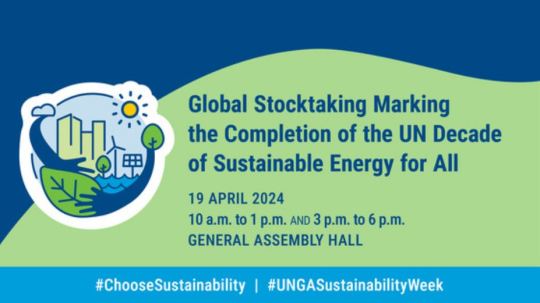
#high-level representatives#UN Economic and social council#ungasustainabilityweek#choosesustainability#UNGA78#decade of sustainable energy for all#SE4LL#ChooseSustainability#energy sector#energy security#energy services#ReliableEnergy#stakeholder partnerships#stakeholders#greenenergy#partnerships#sdg7#energy#innovative solutions#PowerGrid#electricity#investment#sustainable energy#affordable energy#clean energy#energy transition
0 notes
Text
Focus on World Energy Transitions Outlook 2023: 1.5°C Pathway.
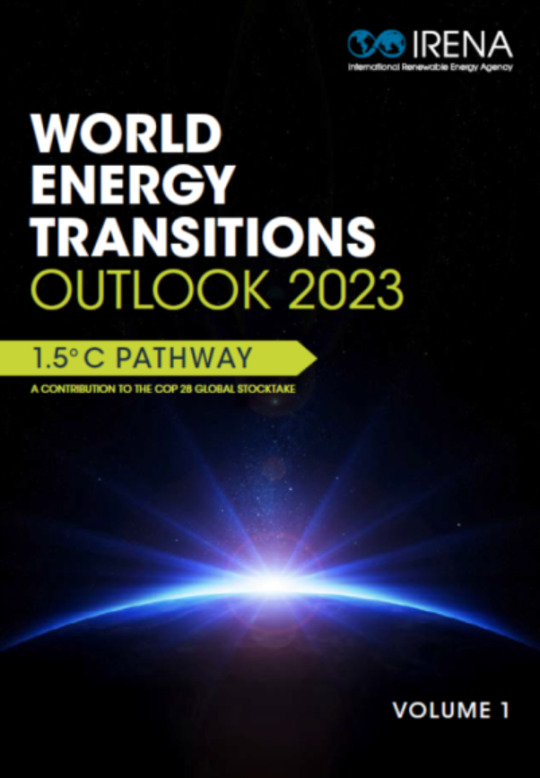
This first volume of the 2023 Outlook provides an overview of progress by tracking implementation and gaps across all energy sectors, and identifies priority areas and actions based on available technologies that must be realised by 2030 to achieve net zero emissions by mid-century.
View
0 notes
Text
Helping to ensure that developing countries benefit from clean energy
The United Nations is helping to ensure that developing countries benefit from clean energy. In Madagascar, a promising initiative is showing the potential of clean electrification to change lives.
0 notes
Text
Will developing countries benefit from the renewables boom?

The technology already exists to bring clean energy to rural communities in developing countries that have previously never had access to any kind of electricity. However, as Moritz Brauchle, managing director of Africa GreenTec Madagascar, explains, these countries will continue to need support to turn their backs on fossil fuels.
Africa GreenTec is a social enterprise which provides sustainable energy solutions to some of the 600 million people in sub-Saharan Africa currently living without any access to electricity. With backing from the UN, the company installs minigrids – stand-alone networks run on renewable energy – to supply people in a small community or town with clean electricity.
Mr. Brauchle spoke with UN News ahead of the first ever International Day of Clean Energy, marked on 26 January.
UN News: What difference can access to clean electricity make to people’s lives in Madagascar?
Moritz Brauchle: It gives me goosebumps when I think about it. When we began our pilot project in a village in 2021, everything was pitch black by 6pm. The day was over. People would go home, cook and go to bed.
As part of the project, we installed solar street lights, cooling and clean electricity. Now, people are selling ice cream and juice on the streets, and they can go to the cinema. The rice mills that used to run on diesel are no longer polluting the air.
UN News: What proportion of the population is living without electricity?
Moritz Brauchle: Around two thirds, unfortunately. The state utility is struggling with financing to expand the grid and connect more people, and they are currently running on diesel, which is very costly and polluting.
So, we go into areas in sub-Saharan Africa, where the people have no access to electricity whatsoever, and we build solar power plants with battery storage and a distribution network and really create energy access from scratch.
Using solar power, combined with batteries for storage, we can achieve a 20-hour supply of electricity in a day. In the last year and a half, we have had two outages lasting between three and four hours. This is better than many traditional grids.
UN News: Is it possible to connect minigrids to cover a larger area?
Moritz Brauchle: That's actually what we are currently working on, together with the German development aid agency: interconnecting minigrids to electrify a complete region. That’s what we plan to do in the next couple of years and in the really long run, integrate into a national grid system.
UN News: Your company receives grants and support for your installations in Madagascar. Can this technology be commercially viable in developing countries without this kind of help?
Moritz Brauchle: Yes, but two things would have to change.
First of all, we would have to earn more from carbon emissions certificates. This means receiving more money because we have helped to reduce carbon emissions by either replacing diesel generators or avoiding the need for new ones.
Secondly, we would need support from the state or, if the state is not capable of doing that, from an international organization such as Sustainable Energy For All to set up the grids because it is costly to start from scratch. Once that is done, we don’t need any subsidies to generate the electricity.
UN News: Was it hard to convince the authorities in Madagascar to move to this kind of energy production?
Moritz Brauchle: No, they’re strongly supportive, and we’re getting cooperation from the Energy Ministry. However, they need time. The regulations were set up for diesel generation, and we have to request environmental permits and submit studies. We need to get rid of this to get more people connected more quickly.

Mahavelona, in rural Madagascar
UN News: What would you say to people in developing countries arguing for the right to develop their fossil fuel reserves?
Moritz Brauchle: We do hear those kind of arguments, and I must say, who are we to tell them to keep those resources in the ground?
For those countries, it’s an income stream. Look at Norway, which is extremely green. It got its wealth from fossil fuel resources.
If we want the Global South to keep oil and gas in the ground, we have to come up with a solution, subsidizing renewable energies and providing compensation for the loss of the income stream.
The Africa GreenTec minigrids projects in Madagascar are supported by the Universal Energy Facility (UEF), which is managed by SEforALL.
#affordable energy#sustainable energy#clean energy#sdg7#international day of clean energy#greentech#solar energy#Universal Energy Facility (UEF)
0 notes
Text
Statement by António Guterres; Secretary-General of the United Nations on the occasion of the International Day of Clean Energy; January 26th.
Clean energy is the gift that keeps giving:
It can purify polluted air;
Meet growing energy demand;
Secure supplies;
And connect billion of people to affordable power – helping to ensure electricity access to all by 2030.
That is all while saving money and saving the planet.
A fair, just, equitable, and urgent transition from dirty fossil fuels to clean energy is essential to avoid the worst of climate chaos and spur sustainable development.
So, I celebrate this first International Day of Clean Energy;
I applaud the work of the International Renewable Energy Agency;
And I welcome the call made by countries at COP28 to triple renewable energy capacity by 2030.
It is my firm belief that fossil fuel phase out is not only necessary, it is inevitable.
But we need governments to act, to accelerate the transition, with the biggest emitters leading the way.
That means unleashing a surge in climate finance – particularly, governments reforming the business model of multilateral development banks so that affordable finance flows.
It means countries creating new national climate plans by 2025 that map a fair and just transition to clean power.
And it means governments closing the door on the fossil fuel era – with justice and equity.
Our clean energy future is unstoppable.
Together, let's bring it into being faster.
Video message by António Guterres, Secretary-General of the United Nations, on the International Day of Clean Energy,
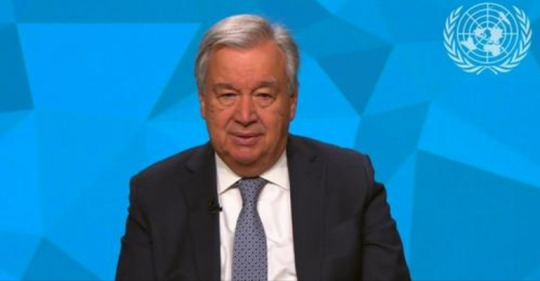
#sustainable energy#affordable energy#26 january#sdg7#international day of clean energy#united nations secretary general#statements
0 notes
Text
Small scale, reliable and renewable: Clean electricity is changing lives in Madagascar.
According to energy industry experts, we're in the middle of a massive expansion of renewable energy sources, and it's likely to continue. At the UN climate conference in Dubai at the end of last year, governments committed to tripling global capacity by 2030, and the International Energy Agency, for one, is bullish about that goal being achieved. But will developing countries benefit?
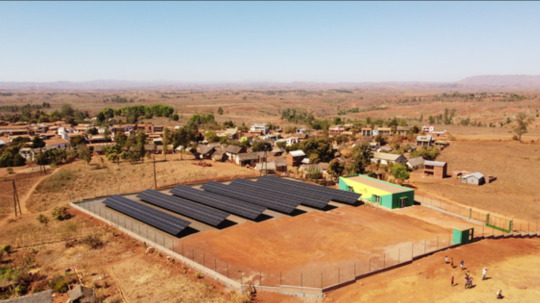
Moritz Brauchle is the managing director of Africa GreenTec Madagascar, a social enterprise which provides sustainable energy solutions to some of the 600 million people in sub-Saharan Africa currently living without any access to electricity.
He explained to Conor Lennon from UN News the advantages of minigrids and how they are breathing new life into communities that were formerly consigned to darkness once the sun went down.
#renewable energy sources#energy sources#sustainable energy#international day of clean energy#26 january#madagascar#solar energy
0 notes
Text
Statement from the Administrator of the United Nations Development Programme and Co-Chair of UN-Energy on International Day of Clean Energy 2024.
“Renewable energy technologies can play a crucial role in providing clean energy access since wind and solar are readily available and in most cases, cheaper than coal and other fossil fuels. And investment in renewables creates jobs — three times more jobs than fossil fuels." - Achim Steiner, Administrator of the UN Development Programme and Co-Chair of UN-Energy

#Renewable energy technologies#clean energy access#Investing in renewables#undp#statement#UN-Energy#international day of clean energy#26 january#United Nations Development Programme#energy commitment
0 notes
Text
Statement by the Special Representative of the UN Secretary-General for SE34ALL and co-chair of UN-Energy on International Day of Clean Energy 2024.
"On this first International Day of Clean Energy, I urge governments, businesses and organizations to make use of Energy Compacts to register or strengthen their energy commitments on the world stage," - Damilola Ogunbiyi, Special Representative of the UN Secretary-General for Sustainable Energy for All and Co-Chair of UN-Energy
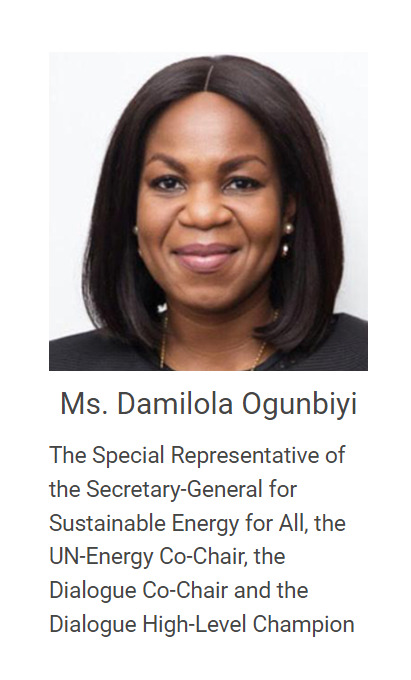
#Energy Compacts#international day of clean energy#statements#26 january#UN-Energy#Sustainable Energy for All
0 notes